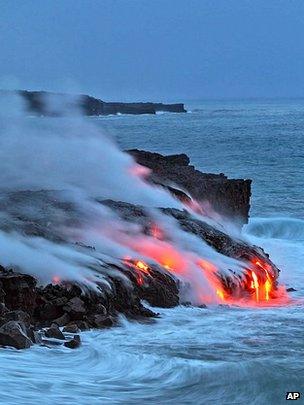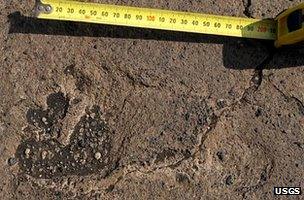Two-faced Kilauea volcano exposed
- Published

The famous lava flows of Kilauea represent a benign threat... and a huge attraction
Hawaii's Kilauea volcano draws two million visitors every year but its photogenic lava fountains and rivers hide a more tempestuous nature.
Scientists say their latest research indicates that explosive eruptions have been far more common in the past than the gentle outflows seen today.
And they warn that a return to this more violent behaviour would require the permanent evacuation of large areas around the volcano.
Kilauea would simply be too dangerous.
"We've found from our work that over the past 2,500 years, which is about as far back as we can see, Kilauea has been in an explosive mode about 60% of the time and in a lava-producing mode, such as it's in now, only about 40% of the time," explained Dr Don Swanson from the US Geological Survey's Hawaiian Volcano Observatory, Hawaii National Park.
"A 60-40 split - this is new and surprising stuff."
Dr Swanson was speaking here at the 2011 American Geophysical Union (AGU) Fall Meeting, external, the largest annual gathering of Earth scientists.
Scientists have long known Kilauea could blow up in a violent way. In November 1790, for example, the shield volcano hurled rock and ash at island communities, killing many hundreds of people. The event is still the most lethal known eruption in the US.
But it is the length of time this explosive phase can be maintained that is novel information.
Scientists think it occurs when there is a drop in the level of molten rock feeding the volcano's conduit to the surface. This can allow surrounding groundwater into the vent to interact with the hot material and flash to steam. If the walls of the crater down which the lava drained then collapse back into the conduit's opening and block it, pressure can build that eventually drives an energetic blast.
Dr Don Swanson: Our view of Kilauea would change dramatically
Dr Swanson and colleagues have now detailed the historic eruptions of Kilauea by radiocarbon dating the charred plant life smothered by explosive deposits.
These investigations reveal a 1,200-year period between 200BC and AD1000 and a 300-year period from AD1500 to AD1800, during which energetic explosions completely dominated the type of benign lava flows that have become so popular with modern tourists and their cameras.
"We found that explosive eruptions are not infrequent events, that they occur over long periods of time and that the hazard from them is much greater than we'd anticipated," said Dr Swanson.
"The good news is that we're not in one of these periods now; we're in a period of lava-flow eruption.

Footprint caught in muddy ash: Evidence of Kilauea's explosive past
"The bad news is that we don't know when the next period of explosive activity may start. And, unfortunately, we can't estimate recurrence interval times because the data are so few and the periods of activity that we can see have been so irregular."
The worry is that should Kilauea's more violent temperament return, it would probably require large areas around the summit to be permanently evacuated. The national park that welcomes huge numbers of international visitors would also have to change its way of operating.
"So much of the island's economy is dependent on volcanic tourism," said Prof Bruce Houghton from the University of Hawaii.
"Could we sustain that tourism if there was a substantial risk to people? As it is at the moment, it is a very benign threat. People can get an adrenalin rush from seeing the lava flow into the ocean, but they're not particularly at risk.
"If we were in an explosive phase with very little notice of an eruption, the only strategy open to us would be to move the population out. The park would become a dangerous place and we'd have to think hard about letting the buses in."